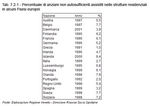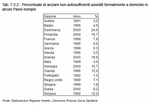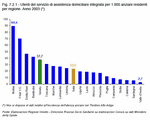7.2 - Equality in fundamental rights: health
True social cohesion means a system that guarantees social rights and access to fundamental services for everyone. The basic right to health is ensured by providing health care for all and granting access to services which respect the principles of human dignity, health needs, equal access, quality and appropriateness of treatments and cost-efficiency in the utilisation of resources. The fight against inequalities in healthcare has also become an issue at European level where a healthy society is considered a prerequisite for prosperity, solidarity and security. To obtain cohesion and solidarity within society it is necessary to reduce the main disparities in health and healthcare which often go hand in hand with inequalities in affluence.
Health promotion is not only about giving the individual a direct personal benefit but is furthermore a key element to sustain economic growth and social wellbeing in the long run. Living longer and in better health leads to a rise in the share of the population active in the labour market, especially as regards the older workforce, and thus to lower early retirement figures and improved sustainability of the economic system. For the implementation of the Lisbon strategy it is therefore crucial to invest in prevention and health. The objective is to increase the number of healthy life-years of citizens by reducing the incidence of diseases and furthering healthy and active ageing. This is done through the promotion of healthier lifestyles and disease prevention programmes and the creation of beneficial living and working conditions. On the other hand, dependent persons and in particular the increasingly numerous elderly people must also be taken care of. Here, integrated long-term care services with a strong focus on home care must be expanded.
The European Commission calls for the maintenance and improvement of service quality and efficiency while taking into account the limits of the public budget. In this context, the healthcare system of the Veneto is able to provide the services and benefits of the so-called Essential Levels of Care (LEA) without putting its financial sustainability at risk. The system is furthermore capable of satisfying the service demand of citizens from various other Italian regions, as is underpinned by the considerable interregional patient flow to the Veneto, in particular as regards hospitalisation figures.
 Healthcare costs and the essential levels of care in the Veneto Healthcare costs and the essential levels of care in the Veneto
The definition of the essential levels of care (livelli essenziali di assistenza - LEA) in the Prime Ministerial decree of November 29, 2001, and the subsequent agreements between the State and the Regions radically changed the model of quantification and allocation of resources for the Italian national health service (Servizio Sanitario Nazionale). Furthermore, a series of important measures were introduced which modified the fiscal relations between the two levels of government and their respective responsibilities, starting with the agreement of August 8, 2001, and ending with the most recent pact for health ("Patto per la Salute") of September 28, 2006. All this shows a clear contrast with the previous scheme of financing the national health service which was based on ex-post coverage of expenditure slippages mainly by the State.
Regione Veneto has met its objectives set for LEA while maintaining a substantial equilibrium in overall financing. The expert body of the so-called Tavolo Tecnico, set up by the Italian Ministry of Economy and Finance to monitor the regions' fulfilment of their obligations, has confirmed that Regione Veneto has covered its deficits, in conformity with the European accounting principles of the ESA 95, for the years 2001, 2002, 2003, 2004 and 2005. This affirmation spared the region the payment of a financial penalty set for defaulting regions (ca. 530 million of Euros) and the immediate rise of the surtaxes of IRPEF (personal income tax) and of the IRAP (regional income tax) to the maximum level.
Against the backdrop of a balanced budget it seems appropriate to take a look at the financial repercussions of the healthcare service provision under the LEA scheme where a shift of attention and resources towards the sectors of regional community activity can be observed.
Cost analysis of the health service agencies, classified according to the LEA scheme, shows for the three years of 2003, 2004 and 2005 a constant increase in costs for all macro-levels (public and occupational health care services, community health care services and hospital care services). However, the growth rates in the individual areas vary, leading to a redistribution of resources. Even though part of the cost increase can be attributed to inflation and the renewal of work contracts and agreements, the growth percentages are still useful at least as an indication of planning objectives.
Costs in the area of public and occupational care went up by ca. 4% from 2003 to 2004 and by 9% from 2004 to 2005. More funds were used up in particular in the fields of hygiene and public health, food control and disease prevention for individuals, while the costs for veterinary services went down slightly. However, this was partly compensated for by the increased activities of the Istituto Zooprofilattico Sperimentale delle Venezie, a veterinary public health institute, which receives special funds to pursue its work.
The costs for community health care services increased by ca. 7% from 2003 to 2004 and by 11% from 2004 to 2005. In particular, the costs for on-duty medical units, local health emergencies, integrative care, specialist care, prosthetic care and home care went up, while the cost increase for pharmaceutical services was partially reduced.
The clear upward trend in the costs of specialist outpatient care continued between 2004 and 2005, mainly because outpatient care has substituted services that were previously provided after hospitalisation only (representing an improvement in terms of the criterion of "appropriateness" of use of hospital structures).
The level of hospital care also registered an increase, but less pronounced and clearly concentrated on curative home care and rehabilitative care. In particular it is noted that in 2005, the total costs for typical hospital activities had become identical to the costs arising from the level of community care services. Even though data for national comparison are not yet available for the entire three-year period evaluated above, it can be stated that the percentage distribution of costs among the three macro-levels in 2005 in the Veneto regions is in line with the values expected and anticipated by the national and ministerial directives.
 Interregional patient mobility Interregional patient mobility
Since 1995 the phenomenon of patient mobility, or in other words, the service provision for citizens resident in other regions than the one where the service is provided, must be handled under a cost compensation scheme which "corrects" the general allocation mechanism based on a per-capita quota calculated according to the resident population of a region.
The national information flow, governed by ministerial provisions and interregional agreements, allows the retrieval of epidemiological as well as administrative information. It provides vital support for the agencies and the regions in the development of programming and monitoring systems. The currently available database, which is built upon individual patient information (in line with the settings used for the new national healthcare information system), is substantial and already allows the compilation of significant time series data. The analysis of integrated data shows that the overall financial balance for the Veneto has consistently been positive and growing, with average values of ca. 110 million Euros in the years from 2000 to 2005. Integrating these data in the national scenario sees the Veneto third in the regional ranking in mobility balance, surpassed only by Lombardia and Emilia Romagna. Patient mobility data regarding hospitalisation only (which accounts for 82% of the total financial value) shows that hospitals in the Veneto register an annual average of 73,000 hospitalisations of residents of other regions than the Veneto for the years 2001-2005. This accounts for a total financial value (calculated on the basis of the regional fees) of ca. 222 million Euros. By contrast, the number of hospitalisations of residents of the Veneto in other regions of Italy amounts for the same time frame to an average of 43,000 per year. This yields a surplus balance of ca. 30,000 hospitalisations per annum for the Veneto.
 Home care Home care
The Regione Veneto has always paid special attention to the regional and community healthcare sectors, adopting an organisational model of service provision which is based on the close interaction of healthcare, health and social activities. This approach meant that a special focus had also been placed on the problems of the information system at community level and led to the activation of specific information channels clearly before a similar system evolved at a national level. These information flows are used to monitor and plan regional community services in the field of psychiatry, integrative home care services or non-hospital residential care facilities.
The current demographic-epidemiologic changes are forcing all European countries to review their models of care organisation. With declining numbers of bed places which are ever more strictly reserved for acute-care patients, investments are more and more targeted at long-term care and on the care settings of home and community (Table 7.2.1) and (Table 7.2.2).
While the number of acute-care bed-places in Italy is in line with European standards, the country is characterised by a generally low level of investments in residential and home care. The regional data are fragmentary and reflect profound differences between the objectives and also the definitions of home or domiciliary care. The most evolved systems have also embarked on curative home care schemes (Figure 7.2.1).
The information gaps have partly been filled through the initiative of the Mattoni project which introduced the new national healthcare information service. Under this initiative, a pilot project was launched in six Italian regions which collected data on integrative home care (Assistenza Domiciliare Integrata - ADI) in three dimensions: the user, multidisciplinary evaluation and services provided. The Veneto has been using a shared information system (definition, evaluation tools, track record, regional data warehouse, web-publication of agency reports) since 2004. Currently, the system comprises data from almost all 21 ULSS (local socio-healthcare units) of the region. More than half of the ULSS can provide coherent track-record data which can be used as historical and geographical benchmarks. It can be clearly seen that in these ULSS the dimension of care in the community for the oldest age cohorts, which includes more and less intensive care services, is of similar size as the in-patient care volume (Table 7.2.3).
The dimension of home care may also be considered in financial terms, analysing the monthly care costs as a function of nearness to death. Besides the vast amount of international literature on the subject, studies conducted in the Veneto have also confirmed the exponential growth in costs in the last 3-6 months of life for all age groups (the following Figure refers to a cohort of 12,000 persons of the Veneto aged 75 plus). Up to 50 years of age, an individual uses on average the same amount of resources in the last year of life as in the course of the rest of his or her life. This gives reasons for a reflection on the objectives of care and services provided to persons in the terminal/preterminal stage (Figure 7.2.2).
The EURELD study (Note 1) pointed out that at least two thirds of the deceased had been interested in making a decision about the type of care to receive at the end of their lives (place and type of care), but less than a third of those patients who wanted care and to die at home were able to actually do so. Considering the complexity of factors involved which include patient preferences, social and family conditions and obviously also clinical aspects, it can be seen that cancer patients who receive care under the ADI are those with the most freedom of choice as regards their place of death. This holds true for tumour patients who had not been hospitalised in the preterminal stage and for those who had been hospitalised only briefly before due to their clinical instability. This purely quantitative aspect goes hand in hand with a verifiable improvement in care procedures in terms of first-aid access (often leading to discontinuation of home care) and access to palliative and opioid therapy.
Home care turns out to be a LEA - essential level of care - of great importance for the governance of the ULSS agencies with a strong potential for development and improvement, also as regards the standardisation of modes and procedures. The diffusion of this level of care is already now significant, as some districts register even more than 42 care-receivers per 10,000 inhabitants.
 Back Back
Notes
- Study on end-of-life decision making using structured questionnaires in six European countries.
|
| Table 7.2.1 |
 |
| Table 7.2.2 |
 |
| Figure 7.2.1 |
 |
| Table 7.2.3 |
 |
| Figure 7.2.2 |
 |
|


 Index
Index 




